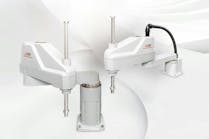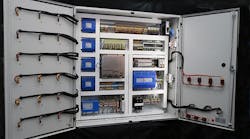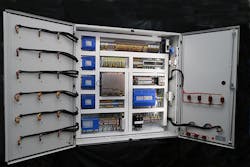Following an extensive remodel and update of a five-story townhouse on the Upper East Side of Manhattan, one detail remained unaddressed: control integration of the HVAC systems. Residents were faced with the prospect of a system that operated erratically and inefficiently. At times, the air-conditioning system would come on at the same time as the subfloor heating system, and humidity levels would vary widely from one area to the next.
The property manager struggled with the daily regulation and monitoring of the facility’s varied air-conditioning and heating systems, soon realizing a dedicated building-management system (BMS) would solve many of the issues he was facing. Controlling and integrating cooling equipment with proprietary communication protocols would not be possible without a conventional large-scale BMS. The building, however, was not large enough to have an engineering office with the dedicated terminal and server most conventional BMS require. Additionally, conventional BMS lacked the flexibility to control small boilers and domestic-hot-water systems.
After considering multiple options, the property manager turned to Advanced System Design (ASD), Milford, Conn.-based designer of custom-built control systems for HVAC, power-distribution, and security and access systems.
Custom Turnkey Solution
When engineers and technicians from ASD initially evaluated the building, they found additional challenges.
“Space was all but non-existent for a new control panel, and all of the major equipment was already installed and in basic operation,” John D. Thompson, president and chief design engineer for ASD, said. “We soon realized that we were going to have to design a compact interconnection solution that would keep the panel as small and compact as possible.”
For ASD, the scenario was not unprecedented.
“Seventy percent of our projects involve coming in after construction is complete and then designing a system to optimize controls for systems that have never operated as intended,” Thompson said. “Changes during build projects and additions to it at various stages without consideration for the controls and monitoring often lead to the owner or property manager having to install a controls system after construction is complete.”
After reviewing a number of possible solutions, Thompson and the ASD team chose the 750-831 BACnet/IP Programmable Fieldbus Controller from WAGO Corp. The extensive range of input/output (I/O) modules allows communication, control, and monitoring of equipment that has no built-in communications with which to interface.
“A lot of times, for projects like the New York townhouse, the various air-handling devices and chiller plants and boiler plants have nothing more than an analog input and/or output for signaling and positioning,” Thompson explained. “They do not have a communication protocol that we can write a program for to communicate with them. With the WAGO 750-831 BACnet controller, we can take advantage of an extensive mixture of BACnet objects, discrete and analog I/O points, to create a custom control-system solution.”
Controller Facilitates Efficiency and Integration
Using the 750-831 controller, ASD set up a BACnet network allowing direct communications with the major HVAC equipment already installed. The 750-831 controller supports the B-BC BACnet device profile according to ISO 16484-5, Building Automation and Control Systems—Part 5: Data Communication Protocol. With two Ethernet interfaces and an integrated switch, the fieldbus can be wired in a line topology, eliminating additional network devices, such as switches and hubs.
By using the 750-831 controller as the primary processor to bring in all of the I/O points, ASD was able to offer not only an integrated control system, but the capability to monitor and program alarms as needed.
“BACnet devices like the 750-831 allow you to read various data points and set alarms based on various values that come in over BACnet,” Thompson said. “We can also then, on the PLC (programmable logic controller) side of the controller, set up our own alarms for the discreet components. With the one controller and the mixture of I/O, we are now able to develop our own alarms and monitoring schemes.”
For engineered-system designers like ASD, proprietary control and monitoring systems do not always fit the bill.
“Designing and custom manufacturing control systems for our clients enables us to come into virtually any project and tailor all our monitoring and data points to what the client requires,” Thompson explained. “With the WAGO controller, we don’t have any limitations as far as what signals we can pick up and the type of communication protocols that need to come in to the controls we are tasked with designing.”
ASD’s solutions resulted in the total integration of all HVAC and humidity equipment. The integration created a control system that operated automatically, making multistage heating and cooling calls as needed.
An added benefit was a substantial gain in efficiency.
“We changed the boilers from on/off control to full modulating staged control using the outside-air temperature as a basis for anticipated heating load,” Thompson said. “This improved the efficiency and operation of the boilers by 32 percent.”
Integration also allowed faster response time to large temperature swings by enabling multistage units to function as designed, bringing in additional heating or cooling as needed, all while maintaining tighter temperature and humidity setpoints determined by the owner.
For Design Solutions author guidelines, call Scott Arnold, executive editor, at 216-931-9980, or write to him at [email protected].










